Back to page 1
The Design
The complex that surrounds Cubs Park is quite impressive — and undeniably “state of the art.” It features the absolute latest in hydrotherapy equipment (including an underwater treadmill that can be viewed by the trainers through a special window in the side of the tank), extensive video capabilities in the batting cages and a massive 12,000-square-foot workout room.
The locker rooms, training areas, hydrotherapy, workout facilities and the Cubs’ springtime front office are all housed in the mamoth two-level clubhouse building. “The size of everything is really helpful,” McLeod explained. “We were really cramped in the weight and training rooms (at Fitch Park, where the team trained through 2013), to the point where if we had more than 12 or 15 minor leaguers wanting to work out at the same time, we had to move some of the equipment outside. Now there’s lots of room in the workout room, plus it looks like a well-equipped fitness club.”
 |
But in the inevitable comparison with Salt River Fields, the complex simply isn’t as elaborate, especially in the aesthetics department. To be fair, though, Salt River was designed and constructed with a seemingly unlimited budget. No expense was spared, right down to the landscaping and the unbelievable decor of the team offices.
By no means is the Cubs’ complex lacking, though … but $84 million doesn’t buy as much as the rumored $220 million spent on Salt River.
Let’s zero in on the ballpark at the center of Mesa’s new complex, and see how it fares when compared to other newer spring-training parks.
First, we must talk about the park’s size. It can hold 15,002 fans when it’s completely full, giving it the largest seating capacity of the 24 spring-training ballparks. This was an imperative from the Cubs’ front office, as was shade. “Tom Ricketts (Cubs’ owner and Chairman of the Board) said he wanted the most shade of any park in Arizona or Florida,” said Populous Principal David Bower. “We designed the park so that over 70% of the seating bowl is in the shadows.” In this respect, Cubs Park is far superior to Camelback Ranch in Glendale, where clearly shade wasn’t much of a consideration when it was being designed.
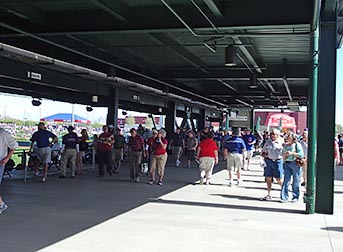  |
Despite the ballpark’s large capacity, there is no loss of intimacy. Cub fan Jim Marshall of Dixon, Illinois, who attended the inaugural game at Cubs Park, appreciated its “close-in feeling, because you could really see the ballgame,” Similarly, when I asked John Radeke, a Chicago native but current resident of Mesa, if the park was so large that it lost some of the intimacy, he responded that “it couldn’t be too large,” but the intimacy wasn’t compromised. “Not at all,” he confirmed.
The corridors are completely open to the field (above left) and provide a lot of shade. Shade is also generated by two large trellised structures down the first base line (above right). Bower pointed out that these freestanding structures are very effective while carrying a much lower cost than other sun-blocking solutions.
The main seating bowl is made up of two decks, as many of the springtime ballparks are (see below left). The upper deck, which holds club seats, a huge party deck, suites and the press area, is covered by a beautiful roof. While it’s not a dead ringer for Wrigley’s roof in relative size, it is very similar in shape and color. Note, of course, the light tower that is so reminiscent of those at Wrigley.
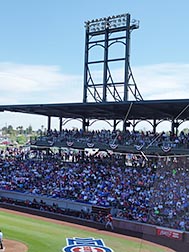 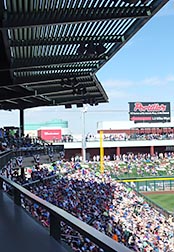 |
The shot on the right side above shows the way a good portion of that roof is trellised, as is the norm in Arizona. In the background you can see the building that holds the uber-popular rooftop deck.
The various seating sections on the rooftop are all the rage, just like the ones across Waveland and Sheffield from the bleachers of Wrigley. There is a mixture of open-air bleachers, covered patios and individual seats along the front railing. The vantage point, by the way, is very similar to the seats on the top of and in the middle of the Green Monster at the Red Sox’ spring-training park in Fort Myers, FL.
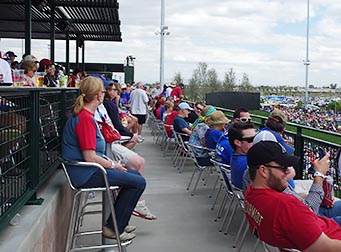 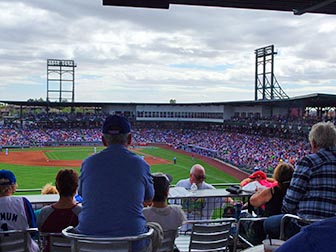 |
The water-treatment plant, which was important to hide from the fans’ view, is located behind the structure whose roof provides these seats. Most of the time, you won’t even realize it’s there.
One very pleasant area within the park’s footprint takes advantage of a current trend: food trucks. Along the outer perimeter of the stadium beyond right field is a fenced-off area that anyone with a ticket can enter. Here you’ll find a small grove of citrus trees, in honor of the fact that such orchards covered this exact spot decades ago. The area is designed so that food trucks — which can vary from game to game — can park along the street, but their serving windows are within the fenced area. Pretty ingenious.
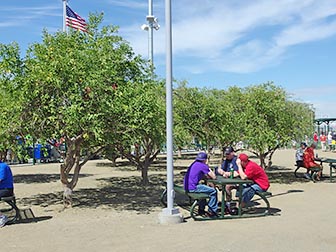  |
The Essentials
In this section, we’ll go over the cost to attend a game at Cubs Park, as well the food and features you’ll find there … and one familiar feature that you won’t find there.
Parking is steep at $7. $5 is the norm, but some parks (like Surprise) don’t charge for parking at all. In addition to paying a lot, you could have a fairly long walk if you have to park in the lot at the northeast corner of the complex off Dobson Road.
Tickets, as you’d expect, are also expensive — and are even higher depending when you buy them and what game you select. When purchased in advance, seats for non-premium games are $34 for infield boxes and $29 for the seats behind them. The next three sections down each foul line (called Outfield Reserve) cost $24, and the last couple of sections (called Bullpen Seats) will run you $18. General admission tickets — which means you can sit on the berm — and passes for the Eighteen 76 Club (the rooftop area in leftfield) are a reasonable $8. The “marquee” games, which account for seven of the 16 home games in 2014, cost exactly $4 more, regardless of your desired seating section. If you wait until the day of the game to make your purchase, your ticket will cost an additional $2. Add service fees to that if you’re buying online, and it can really add up.
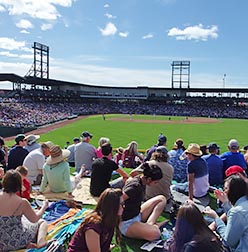 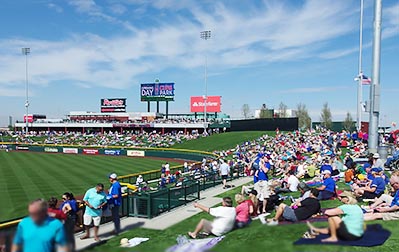 |
Fan Jim Marshall (quoted above) didn’t feel ripped off in the least. He reported that he’d bought four tickets for all of the home games in Mesa this spring. “I thought (the ticket prices) were fair, really fair.”
Ovations is the food-service vendor, just like at Salt River. At Cubs Park, they chose the themes and quantity of concession stands differently. At Salt River, there are 55 concession stands and kiosks (accounting for 110 points of sale), many of which specialize in only one type of food. At Cubs Park, there are fewer — but larger — stands, usually with a variety of foods.
The Taste Of Chicago stands are the most noteworthy, because fans from the Midwest can eat dishes familiar to them. Here you’ll find Chicago-style hot dogs (served on a poppy-seed bun, of course) for $8, personal-size, thick-crusted pizza for $7 and an Italian Beef sandwich for $10. Chicago native John Radeke (quoted above) said, “The food was marvelous. The selection was wonderful. I got the Italian Beef (and) it was very tasty. It reminded me of what I ate as a child (in Chicago).”
The Windy City Dog stand behind third base features the same Chicago-style dog, while adding the Mesa Dog (topped with guacamole, diced tomatoes, chilies and tortilla strips) and a Wrigley Dog smothered in pulled pork, sport peppers and BBQ sauce. All of the hot dogs are $8.
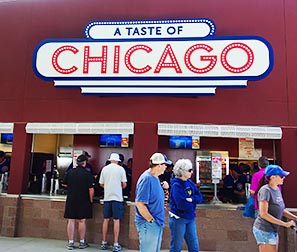 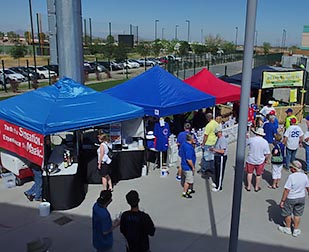 |
At The Show Ballpark Grill, they feature several chicken dishes as well as a “Healthy Fare” menu that includes two types of salad (both $10), a fruit-and-yogurt combo for $7 and a vegetable crudite for $6. You can find Southwest fare at the cleverly named Rendezvous Park Grill (named for Mesa’s first ballpark) and Mesa Flats Tortillas (or perhaps it’s really named Mesa Tortillas Flats. The sign is open to interpretation). There you’ll find a meatless burger made with black beans for $10. For burgers with real honest-to-goodness meat, there’s a hamburger specialty stand behind the berm in left field.
There are several free-standing kiosks simply called “Grill” that featured a boneless rib sandwich for $8 and a cheesesteak for $9.
And at all of the stands, draft beers are $7.50 while premium drafts are $8.50.
Yes, all of these represent Major League prices at a spring-training park.
And it’s nice that the food trucks will change from game to game, providing some variety to fans who attend multiple exhibition contests.
If you’re thinking that the theme of “high prices” will be broken when you shop in the souvenir stores, you’ll be mistaken. The largest (3,600 square feet) of the three stores is behind first base, and it features kids T-shirts that run $20 – $31, while adult T-shirts range from $30 to $34 and adult caps $30 – $38. The store is beautifully laid out and decorated, though, plus it features doors that open to the exterior of the park, so they can offer stores hours when the ballpark isn’t open.
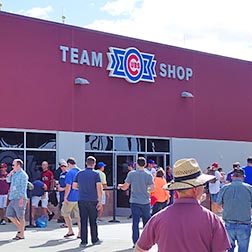  |
Like at Salt River Fields, there is a wiffle-ball field at Cubs Park (below right). At Camelback Ranch in Glendale, though, they must feel the same about kids as they do about shade: no reason to work them into the design of the ballpark.
The scoreboard beyond left field is larger than the one at Camelback Ranch, but its video screen is smaller (901 square feet to 1,152) than at Salt River. Further, the structure that holds the board at Cubs Park is actually outside the perimeter of the park, just behind the large building beyond left field. That allows it to be seen by the hordes who frequent the rooftop deck (by looking over their shoulders), but that makes it a good distance from those in the main seating bowl. Beverly Knickerbocker, a resident of Mesa who, like many at the inaugural game relocated from Illinois, told me that her only complaint about the park is that the “scoreboard is too hard to see. Everyone around me thought so, too.”
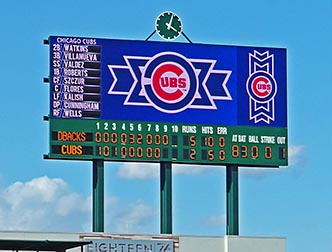  |
One feature that every fan seemed to enjoy is the large sign on the first-base concourse, It pretty much duplicates the iconic marquee above the home-pate entryway at Wrigley, but with three main differences: it’s not on the facing of the stadium’s exterior (it’s completely inside the ballpark); it has two sides instead of just one; fans can have an attendant enter their names into a computer a few feet away and then their name appears on the marquee of the sign. Talk about a fantastic photo opportunity! Best of all: there’s no charge to do this. A simply outstanding idea.
 |
Alas, there is something missing, though. During Cubs games at HoHoKam, the wonderful sounds of a live organist could be heard. That is not the case at Cubs Park, as the team made a conscious decision to go with only pre-recorded music over the PA system. One team official told me that they would sometimes play recordings of the organist at Wrigley, but I heard none at the opening game. That’s really a shame, because it’s not just the sights, smells and tastes that make a ballpark a ballpark. It’s also the sounds.
The lack of organ music was particularly apparent when Cubs Hall Of Famer Fergie Jenkins hopped on top of the Cubs’ dugout to lead the crowd in Take Me Out To The Ballgame. It was fantastic to see Fergie, but it was sad that it wasn’t live organ music accompanying him.
Other than that, I’d be hard-pressed to come up with anything about the fan experience at Cubs Park that is lacking.
Summary
“The Cubs’ complex is a game-changing experience for spring training,” said Populous’ Bower. “This really raises the bar for player development, fan amenities and for revenue generation for the city and the team. This is really today’s state of the art of the business of baseball.”
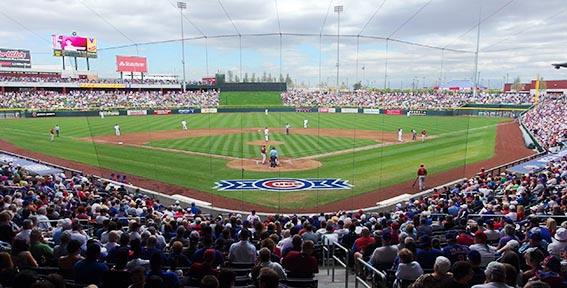 |
The Cubs agree that they have a winner. Even if it won’t impact the standings right away, the complex is as nice as it gets. Cubs’ Senior VP McLeod revealed that “we feel a big-time sense of pride when we walk around and see that we have a facility that is the best of the best.” Randy Bush, the team’s assistant GM, told me that the Cubs “wanted to do something really special for our fans. We’ve tried to bring a Major League atmosphere and it looks like the fans really like it.” Agreed.
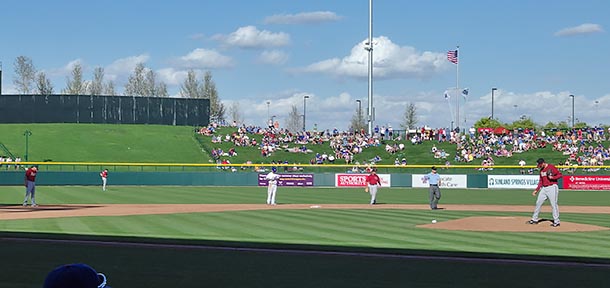 |
If you’ve visited Cubs Park or have any thoughts about it, please post them below.